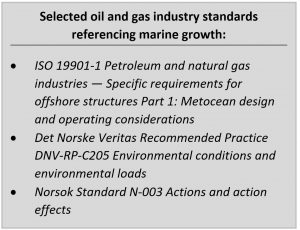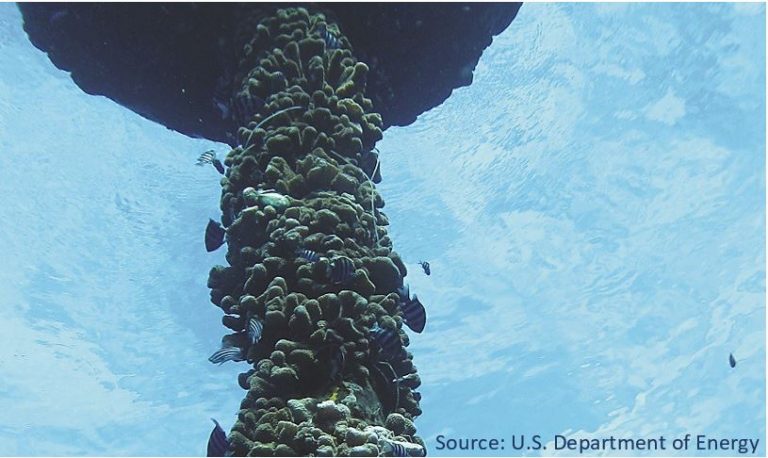ISSUE NO. 11: MANAGING MARINE GROWTH IN THE OFFSHORE RENEWABLES INDUSTRY: LESSONS LEARNED FROM OIL AND GAS
Management of marine growth (a.k.a. biofouling or epifauna/epiflora) is an important engineering and ecological consideration during the design, operating, and decommissioning phases of offshore energy production. There are a variety of industry standards defining engineering considerations for oil and gas installations (see inset), as well as a long history of scientific research that  relates to the description and management of marine growth on offshore oil and gas infrastructure. However, there is a relatively smaller (but rapidly growing) amount of this knowledge in relation to the offshore renewables industry. As offshore renewable energy installations become more widespread—the Global Wind Energy Council estimates global installed offshore wind energy capacity will increase from 18 GW to 120 GW between 2018 and 2030—there is opportunity to make use of the lessons learned and the best practices developed in the oil and gas industry in relation to dealing with marine growth.
relates to the description and management of marine growth on offshore oil and gas infrastructure. However, there is a relatively smaller (but rapidly growing) amount of this knowledge in relation to the offshore renewables industry. As offshore renewable energy installations become more widespread—the Global Wind Energy Council estimates global installed offshore wind energy capacity will increase from 18 GW to 120 GW between 2018 and 2030—there is opportunity to make use of the lessons learned and the best practices developed in the oil and gas industry in relation to dealing with marine growth.
Marine Growth Impacts and Management
Once a hard substrate (oil rig, sea wall, pipeline, ship wreck, turbine footings, etc.) is placed in the ocean, its surface rapidly is rapidly covered in a biofilm of microbes and microscopic organisms such as diatoms, fungi, and additional bacteria. This biofilm is a suitable surface for the adherence of larval epifauna/epiflora such as barnacles, mussels, anemones, hard and soft corals, sponges, bryozoans, algae, and sea squirts, with specific community composition dependent on local environmental conditions.

The colonization of a structure by these organisms increases habitat suitability for a variety of other benthic and pelagic organisms including invertebrates, herbivorous and carnivorous fish, reptiles, and mammals. The offshore structures begin to function as an artificial reef and may form a hotspot of biological productivity. This new habitat and increased productivity can have positive environmental and social effects (e.g. new habitat for protected corals, destinations for recreational scuba diving, fish aggregation to the benefit of commercial and recreational fishing). However, there are also risks, including increased spread of invasive species and negative interactions between humans and protected species, as well as challenges in managing the impacts of marine growth on the installations themselves.
The presence of these biofouling communities changes the hydrodynamics, structural loading, thermodynamics, and corrosion properties of an offshore structure. These changes require engineering consideration during the design, operations, and decommissioning of the structure (at the time of decommissioning, accumulated marine growth may represent up to 10% of the mass of a structure). Best practices for managing growth during operations include cleaning and inspection of subsea infrastructure using divers or remotely operated vehicles (ROVs), and application of antifouling products. During decommissioning, best practices include reuse of offshore structures as artificial reefs (Rigs-to-Reefs programs), cleaning structures at sea and transporting components to shore for recycling, or transportation to shore where marine growth is removed from the structures and landfilled. Decommissioning regulations vary substantially by country and region, so options such as Rigs-to-Reefs programs are not available in all oil and gas producing areas.
Learning from Offshore Oil & Gas Industry Experience
Although there is a long history of research into marine growth and the artificial reef effect of offshore structures in the oil and gas industry, offshore renewable energy is a newer industry so there has been less opportunity to research and monitor projects throughout their entire lifecycle. In many ways, the impacts and behaviors of marine growth are quite similar to effects in the oil and gas industry. Renewable energy structures are colonized by epifauna/epiflora, resulting in a reef effect. Rock dumping for scour protection at turbine footings has similar ecological effects to rockfill or concrete mattresses covering oil and gas pipelines. Even removal of infrastructure from the sea during decommissioning may be expected to have similar ecological effects (benthic habitat disturbance, sedimentation) as the removal of oil and gas infrastructure.

However, there are differences and considerations required for marine growth in the offshore renewables industry will depend significantly on the type of energy production and the technology used. Growth on the footings of an offshore wind turbine may have little impact on the function of the turbine, while having a broader impact on the biological productivity of the surrounding environment. Conversely, biofouling on the blades of a tidal turbine or wave energy device could have substantial negative impacts on the function and efficiency of the device. Impacts of biofouling on floating solar panel installations are much less documented but may include changes to heat regulation and buoyancy characteristics of the installations.
Ecosystem-level function and effects of offshore renewable energy infrastructure may also differ from those of offshore oil and gas structures. Whereas an oil production platform might function as a single small reef, a wind farm with many turbines would function as a network of small interconnected reefs with the associated ecological effects of high connectivity (dispersal, colonization, energy flow, etc.). This connectivity extends not only vertically through the water column, but also horizontally across the entire wind farm installation. Ecosystem-level impacts of floating wind turbines or other floating renewable energy devices may also differ from bottom-fixed energy infrastructure (renewable or petroleum) as floating infrastructure would provide habitat/substrate only near the surface of the ocean. This limits the diversity of species that may colonize these devices but may also broaden the geographic area of benthic impacts due to falling epifauna/epiflora transported by currents prior to reaching the ocean floor.
Opportunities for Improved Marine Resources Management
Overall, the management of marine growth in marine renewable energy development presents many opportunities. By accounting for the ecological effects of marine growth on offshore energy infrastructure during its lifespan and decommissioning, governments and managing bodies can adopt an ecosystem-based approach to marine management frameworks. Additionally, the scientific community has an opportunity to study the interactions between artificial structures and marine ecosystems on a new scale.

Finally, the offshore renewables industry has an opportunity to incorporate best practices and lessons learned from the oil and gas industry, as well as scientific knowledge, into planning, operations, and end-of-use strategies. The extensive body of industry knowledge regarding the implementation of Rigs-to-Reefs programs is directly applicable to the decommissioning of offshore renewable energy, as is the body of scientific research on the ecological effects (both risks and benefits) of offshore infrastructure on the marine environment. Multiple decommissioning strategies not available to the oil and gas industry (for instance, refurbishment or re-powering of offshore wind farms) present opportunities to maintain economic viability of an offshore power installation for longer periods and may extend the time period before decommissioning operations (expensive, and likely to have widespread ecological impacts) are necessary.
Navigating the environmental and social risks facing the energy industry will continue to be a critical determinant of controlling costs, keeping projects on schedule, and maintaining the sustainability of operations. Acorn International looks forward to continuing to help the offshore energy industry transfer applicable best practices from oil and gas to renewables, and to find new ways to promote sustainability in our oceans.
References/additional reading:
Causon, PD and Gill, AB. 2018. Linking ecosystem services with epibenthic biodiversity change following installation of offshore wind farms. Environmental Science and Policy, 89:340-347.
Krone, R, Gutow, L, Joschko, T, and Schröder, A. 2013. Epifauna dynamics at an offshore foundation – Implications of future wind power farming in the North Sea. Marine Environmental Research, 85:1-12.
Topham, E and McMillan, D. 2017. Sustainable decommissioning of an offshore wind farm. Renewable Energy, 102:470-480.
________________________________________________________________________________________________________________________
Acorn International LLC delivers social and environmental risk management consulting services to the extractive industries and investors worldwide. We work with local partners in over 70 countries worldwide. Use of these local specialists is paramount, particularly in developing countries, where information is often scarce, second-hand, and unreliable. We look forward to engaging in continuous improvement for the industry and building capacity with our partners.
